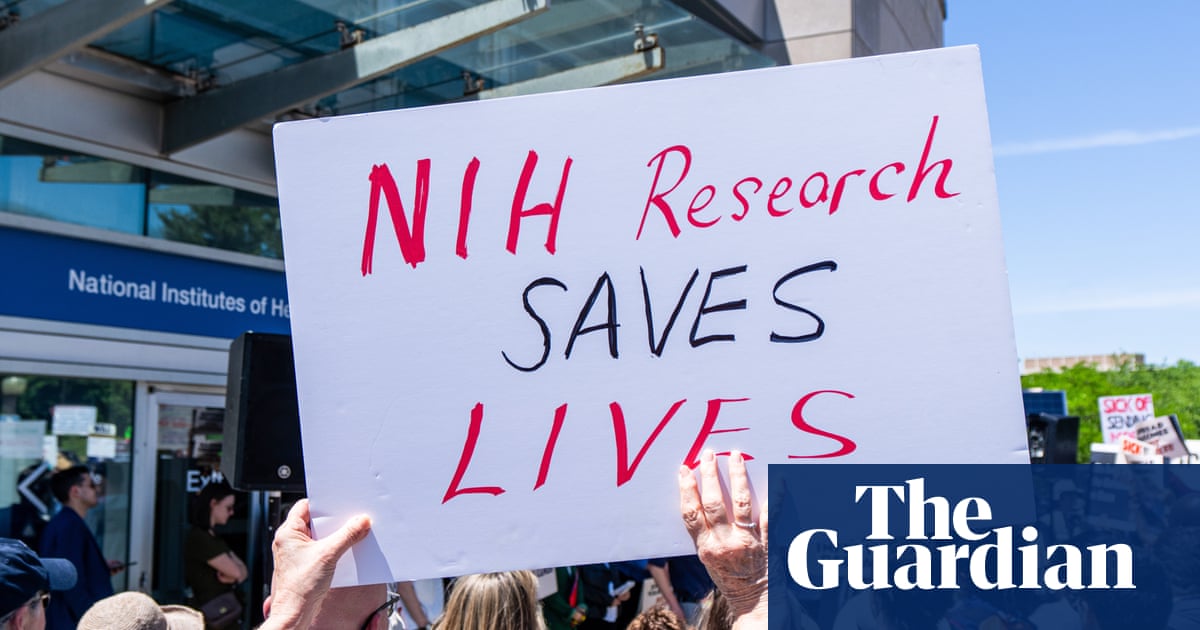More patients may die as a result of plans drawn up by theTrump administrationto cut billions of dollars from the National Cancer Institute (NCI), veteran federal government workers and experts have warned.
Nearly $2.7bn would be cut from the agency, which is the largest funder of cancer research in the world – a decline of 37.2% from the previous year – under a budget proposal for 2026, in the latest effort to cut staff and funding.
“These cuts are absolutely gut wrenching,” Erin Lavik, former deputy director and chief technology officer at the NCI’s division of cancer prevention, told the Guardian.
Lavik was fired along with a swath of probationary workers at the institute in February; put on administrative leave in response to a judge’s ruling to halt the firings in March; and then terminated again in April.
“We’re not making things more efficient or better,” she said. “What’s being left is sort of the non-impactful iterative work, and we’re pruning all of the potential for transformative science.”
The American Cancer Society Cancer Action Network has cautioned that the proposed cuts “will set this nation back dramatically in our ability to reduce death and suffering” and noted that cancer is expected to kill more than 618,000 Americans this year.
Julie Nickson, vice-president of Federal Advocacy and Coalitions, said: “This wouldn’t just be a blow to science, it’s a blow to families, communities, and our economy. Every day counts in the fight against cancer and with more than 2 million Americans expected to be diagnosed with this horrible disease in 2025 alone, now is not the time to go backwards.”
Jennifer R Brown, secretary of the American Society of Hematology and director of the Chronic Lymphocytic Leukemia (CLL) Center of the Division of Hematologic Malignancies at Dana-Farber Cancer Institute, told the Guardian that cuts under Donald Trump have “already been devastating”, with key research halted that can’t easily be restarted.
“What the public needs to know is that the science that may not sound so obvious, or that they may not know that much about, is really what drives our cancer treatments and our cancer cures. And so if we cut that, we’re going to lose it,” said Brown.
Cancer research historically funded by the National Institutes of Health (NIH), which houses the NCI, “is the basic science that figures out what to target in the cancer cell”, she said. “Then a drug may be developed that may be from an academic, it may be from a pharma company, but the trials are then also run by academics and pharma in collaboration, and academics who are funded by NIH, who do the legwork to figure out how the drug is working in patients.
“Pharma companies take the drug to the finish line. And so if we don’t have this basic research, we’re not going to be able to identify new targets, and that means we’re not going to have new therapies, and ultimately more patients may die.”
Brown sees a direct link between NIH-funded academic research and cancer drugs for chronic lymphocytic leukemia that helped patients live longer.
“People who would have died in a few months, lived for years with the first version of this drug,” she said.
Hundreds of staff have been terminated from the NCI in recent months, including dozens of communications workers. “Our website, cancer.gov, is used worldwide and is the ground truth for cancer information,” said one fired communications employee at the institute, who requested to remain anonymous. “Science isn’t finished until it’s communicated.”
Between 28 February and 8 April, more than $180m in NCI grants were cancelled by the Trump administration.
Sign up toThis Week in Trumpland
A deep dive into the policies, controversies and oddities surrounding the Trump administration
after newsletter promotion
NIH declined to comment, deferring to comments on the budget proposal cuts to the office of management and budget, which did not respond to requests for comment.
NIH did not comment on how many employees at the agency remain after several rounds of cuts and layoffs.
Lavik said the cuts are likely to threaten large-scale research programs, such as the National Community Oncology Research program, which covers community hospitals all over the US and ensures patients have access to clinical trials, cutting edge cancer care, prevention and screenings.
“I am deeply concerned about the future of these really important clinical trials programs that are really hard to rebuild if you stop them,” she said. “In the prevention program, there are large scale screening trials, and they have large data sets. We were working really hard on policies to make those data sets more accessible and available to the research community. And we’re all gone.”
Drastic cuts across federal science funding is causing scientists to consider leaving science and eliminating opportunities for younger scientists to enter training pipelines as undergraduate researchers, graduate researchers and postdocs, according to Lavik.
“The things that are transformative are fundamentally high-risk, high-reward research,” she said. “We start to move into the clinic, and that’s what leads to the new kinds of treatments that don’t just help a little bit, but really change the face of how we treat patients, how we prevent cancers, how we treat other conditions.
“You have to be willing to do lots and lots of things that don’t work. There are so many ways we should be more efficient about what we do. But to do that, you really need those young scientists, those new people in the field; you need the people who’ve come into the NIH and the NCI, who are thinking differently about doing things and willing to take those big swings.”
